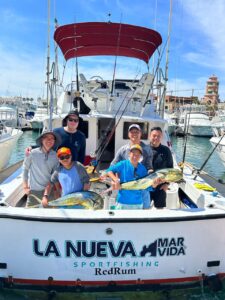Dorado, also known as Mahi-Mahi or Dolphin, is a large gamefish that can grow to be over 3 feet in length and weigh well over 50 pounds. They are a migratory pelagic species that live in schools in both tropical and temperate seas.
The name Dorado is Spanish for ‘golden’ and is derived from their coloration which ranges from silver to iridescent blue green. They are the most common Dolphinfish and are a member of the Coryphaenidae family.
How to Catch Dorado Spearfishing
Dorado are a voracious predator and will devour almost anything. They are often very fast and elusive to Spearfish for. You should be able to find them around schools of baitfish.
Where to Fish for Dorado
The best Dorado fishing can be found on both the Atlantic and Pacific Oceans in Central America, with numbers peaking during the summer months as the fish follow the warm currents inshore looking for a meal. They can be caught in shoals that stretch out for kilometers, which is very exciting to watch and photograph.
How to Eat Dorado
Dorado can be delicious if prepared properly. They are very mild in flavor and can be served on a salad, with rice or as a main dish. They can be enjoyed both raw and cooked
How to Cook a Dorado
To prepare a Dorado fillet, use a sharp knife to cut the skin from the head to the tail. You can also peel it, just like Salmon. You can sear Dorado, cook it on the grill, prepare it in a sashimi or a ceviche.
Dorado Fish
Dorado fish are one of the most recognizable, acrobatic and powerful fighting gamefish in the world. Their high jumps and arm-wrenching strike have captivated anglers from around the globe.
They are opportunistic feeders and will take a variety of lures and flies on both surface and sub-surface currents. They tend to be more interested in flies that are flashy and shiny in color.
Size
The Dorado fish is one of the largest and most coveted species in South America. It’s known for its size, beautiful appearance and taste.
The typical Dorado is one meter long and weighs 7 to 13 kilograms (about 15 to 29 pounds). Larger specimens can weigh as much as 18 kilograms to 50 pounds.
Dorados are brightly colored in shades of blue, green and gold. Their pectoral fins are iridescent blue, and their backs and flanks are green and silvery-gold.
Dorado are opportunistic feeders, feeding mainly on small fish and squid. They are also known to school together, which can make for great fishing opportunities.
Habitat
Dorado fish are a cosmopolitan species that can be found in tropical, subtropical, and temperate seas throughout the world. They are a member of the Dolphinfish family Coryphaenidae and are also known as Mahi-Mahi or common Dolphinfish.
These ray-finned fish are pelagic and tend to prefer open water. They can swim up to 280 feet (100 meters) deep and can often be seen hanging out under floating objects such as ships or sargassum.
They are a piscivore and eat a variety of fish including Mackerel, Tuna, and other large predators. They are a good source of protein and omega-3 fatty acids, which can help protect against chronic disease.
Dorado fish are vulnerable to climate change and habitat degradation. They are also threatened by overfishing, which can negatively impact their population. Fortunately, sustainable fishing practices and consumer awareness can help ensure that Dorado fish remain abundant in the future. Responsible fishing techniques include implementing quotas, reducing the use of harmful fishing gear, and protecting their habitats.
Diet
Dorado fish are an important part of the diet of many hobbyists. They eat a variety of food items, including sardines and Pacific Mackerel. They can also be trained to take pellets formulated for larger fishes.
The Dorado is a ray-finned fish that can be found in temperate, tropical and subtropical waters. They have a distinctive appearance, with a compressed head and long, single dorsal fin.
Their beautiful golden-green scales give them the name Dorado, which means “gold” in Spanish. They can live up to five years, but their growth rate is among the fastest for fish in the world.
Dorado are high in protein and rich in vitamins and minerals. They contain vitamins A, B1, C and E, calcium, iron, phosphorus, zinc and iodine. These nutrients are extremely useful for human health, and eating Dorado fish on a regular basis prevents atherosclerosis, lowers blood cholesterol levels, normalizes the level of blood sugar and strengthens the immune system.
Breeding
Dorado fish, also known as Mahi-mahi, live in tropical latitudes throughout the world. They are beautiful fish with golden-colored sides and green or blue undersides.
These amazing fish can grow to over 2 feet long and weigh more than 30 pounds! Their enormous size means that they must be kept in a large aquarium.
When they are young, Dorado fish spawn in a special area in the center of rivers. These areas are flooded seasonally with fresh water and nutrients. The floods create the perfect nursery for Dorado, where they grow from 6 months up to two years before moving to the deeper seas.
Dorado fish eat a variety of different foods, ranging from smaller insects to small fish. However, their favorite food is a Mullet-like fish called Sabalo.
How to Cook Dorado Fish
There are many ways to prepare this fish, but the most common way is to grill it. It’s easy to do and results in a delicious, flavourful dinner.
To prepare Dorado for grilling, remove it from the refrigerator at least half an hour before cooking. This will help prevent condensation from forming on the fish, which can cause it to stick to the grill.
Rinse the fish well under running water to remove any excess mucus or algae from its scales. Pat dry and season with salt, pepper and olive oil.
Slice three vertical slits down the sides of each piece of fish, then massage salt and pepper into the slits using your hands. Dust with flour, and fry in a medium-high heat skillet until the skin is golden brown and crisp and the inside of the slits are cooked (about 3 minutes).
How to Grill Dorado Fish
To cook Dorado on the grill, you will need the following ingredients: 1 lb Dorado fish, 2 cups tomato, 2 tsp onion, 2 cloves garlic, 4 tablespoons butter, 2 bay leaves.
Clean the fish, rinse it, cut the fins and tail, gut belly and head without cutting off the gills, then wash under running water. You can also marinate the fish in yogurt, sour cream or fruit vinegar.






